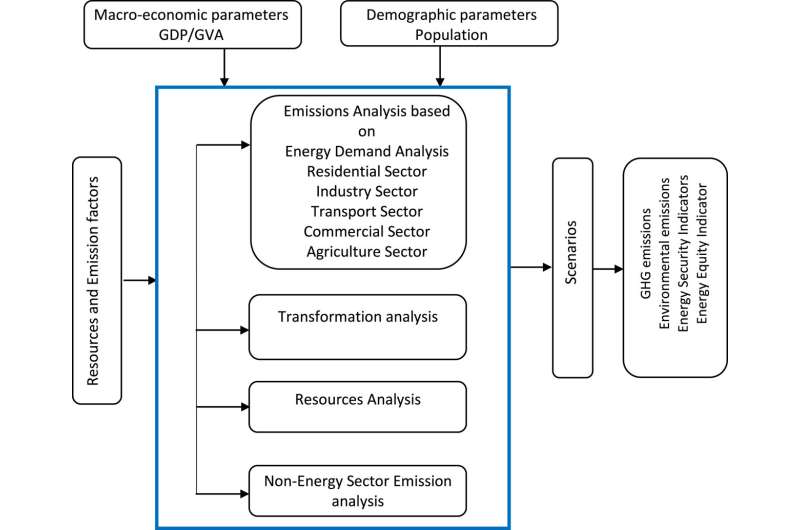This article has been reviewed according to Science X's editorial process and policies. Editors have highlighted the following attributes while ensuring the content's credibility:
fact-checked
trusted source
proofread
Benefits of the net-zero emissions strategy for Nepal

Achieving the goals of the Paris Climate Agreement will require the combined efforts of states and companies around the world. How can developing countries achieve carbon neutrality and boost their resilience while pursuing economic growth and improved living standards? A study by the Research Institute for Sustainability (RIFS) draws on the example of Nepal to analyze the benefits of a net-zero emissions strategy.
Nepal is among the 10 countries most vulnerable to climate-change-related disasters and risks. However, its contribution to global greenhouse gas emissions is minor. As Nepal prepares to graduate from the category of least developed countries to middle income countries, anticipated by 2030, its consumption of fossil fuels is likely to continue to rise.
Nepal's supply of fossil fuels is mostly imported from the neighboring country of India. However, its total export earnings are not sufficient to pay for the imports of petroleum products, raising concerns about future energy security. At the same time, Nepal is still in the process of securing universal electricity access for its citizens as well as achieving various other economic development goals. Nevertheless, Nepal has continuously and actively supported international efforts on climate change mitigation and adaptation.
In 2020, Nepal submitted its second Nationally Determined Contribution (NDC) under the Paris Agreement, with quantified mitigation targets and supporting measures to reduce greenhouse gas emissions. In 2021, the country adopted a long-term strategy (LTS) for net-zero emissions, which aspires to achieve sustainable net-zero CO2 emissions by 2045.
Methods of this study
In their study, "Environmental, energy security, and energy equity (3E) benefits of net-zero emission strategy in a developing country: A case study of Nepal," the researchers examined Nepal's long-term strategy for net-zero emissions using the Low Emissions Analysis Platform (LEAP), a modeling tool developed by the Stockholm Environment Institute.
The tool includes both energy-related and non-energy-related emissions within a single modeling framework and incorporates GHG and other environmental pollutant emission factors as per the IPCC guideline for national GHG inventories. In addition, LEAP enabled the researchers to analyze interactions and their implications between the energy and non-energy sectors, the business sector and the environment.
The study aims to fill a research gap by analyzing for the first time various co-benefits of Nepal's long-term strategy for net-zero emissions relating to:
- Emissions of seven other air pollutants in addition to greenhouse gases (CO2, CH4, and N2O), namely: carbon monoxide (CO), nitrogen oxides (NOX), non-methane volatile organic compounds (NMVOC), sulfur dioxide (SO2), particulate matter (PM2.5), soot and organic carbon (OC)
- Energy security was analyzed in terms of the accessibility, availability and affordability of energy
- The impact of the net-zero strategy on energy equity was measured in terms of access to sufficient electricity, as envisioned in SDG 7
The study examines two major policy intervention scenarios and compares their impacts on these parameters against a reference scenario (REF). The latter assumes that current trends will continue into the future and does not take into account recently adopted policy measures. The With Existing Measures scenario (WEM) takes into account plans and policy measures adopted through to 2020. A third scenario—With Additional Measures (WAM)—also takes into account the impacts of additional mitigation actions that are feasible for the country.
Compared to the reference scenario, both of these scenarios promise to deliver large reductions in air pollutant emissions and improved energy security as well as equity.
Air pollutants: Possible reduction of approximately 70%
For example, under the WEM scenario emissions of seven different air pollutants would be reduced by at least 40% by 2050. Under the WAM scenario, this reduction would increase to about 70% or more. Reductions in air pollutants, including short-lived climate-forcing pollutants (SLCPs) such as soot and methane, would provide additional benefits from avoided adverse health outcomes and crop yield losses, along with reduced impacts on glacier melting and climate.
Energy security would also improve as the share of renewables in the country increases while energy imports decrease. This would translate into a decrease in the imported fuel cost to GDP ratio.
The study examined whether net-zero GHG emissions strategies—in this case in Nepal—can also deliver additional benefits. These co-benefits, such as improved health outcomes and energy security, must also be considered in the development and implementation of decarbonization options, the authors argue. Doing so would help to address various constraints relating to the competitiveness, acceptability, and sustainability of low-carbon options.
The findings of this study will provide valuable guidance for decision-makers during the evaluation of existing and future policy options with respect to investment decisions, the prioritization of research and development needs, and the promotion of societal change in the pursuit of sustainable development pathways. Further studies could be undertaken to quantify, for example, the benefits for human health or the effects on agricultural yields of reductions in environmental emissions as Nepal treads its net-zero pathway.
The study is published in the journal Energy Reports.
More information: Shree Raj Shakya et al, Environmental, energy security, and energy equity (3E) benefits of net-zero emission strategy in a developing country: A case study of Nepal, Energy Reports (2023). DOI: 10.1016/j.egyr.2023.01.055
Provided by Helmholtz Association of German Research Centres





















